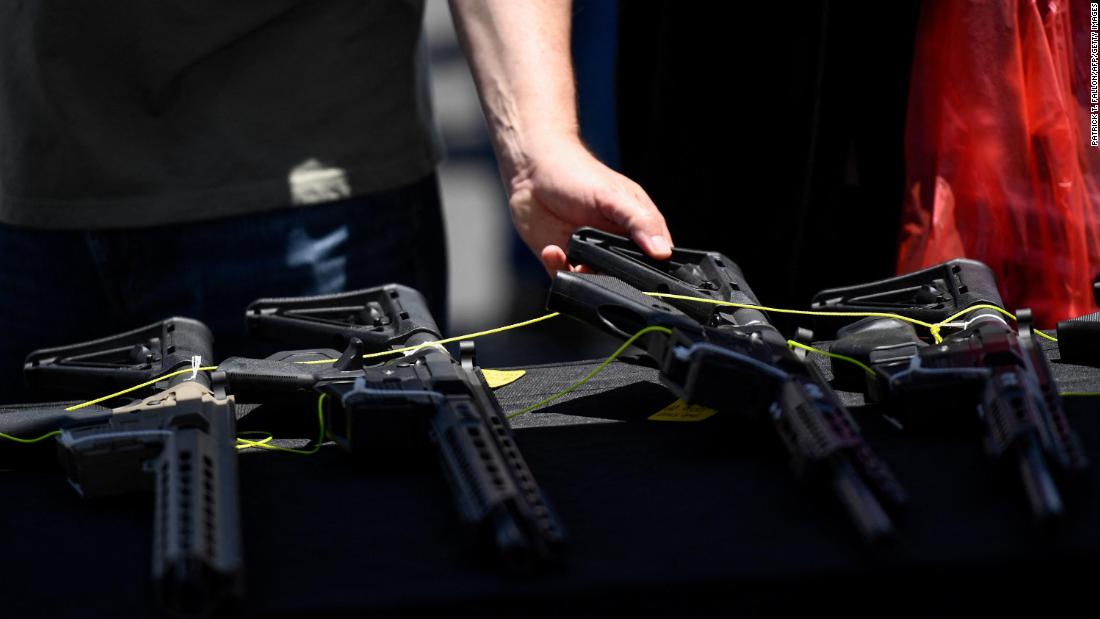
Judge Roger Benitez wrote that the weapons under California's ban were not "extraordinary weapons lying at the outer limits of Second Amendment protection," writing that "(t)he banned 'assault weapons' are not bazookas, howitzers, or machineguns."
"Those arms are dangerous and solely useful for military purposes," he continued. "Instead, the firearms deemed 'assault weapons' are fairly ordinary, popular, modern rifles."
The ruling comes as the US contends with an uptick in deaths from gun violence and repeated weekend spates of mass shootings -- and as President Joe Biden is urging a deeply divided Congress to consider, again, legislation to help avert the violence.
Most of the legislative solutions under negotiation in Washington today focus on background checks. The federal assault weapons ban expired in 2004 -- but, along with California, several states have passed assault weapon bans, albeit with varying lists and definitions of which and what types of firearms qualify as assault weapons.
The term does not have a technical definition and is used by some to refer to all types of guns -- including rifles, shotguns and pistols. There is no specific caliber size, speed at which the weapon fires or other technical measure used to classify a gun as an assault weapon.
The gun-control advocacy group Giffords defines assault weapons generally as firearms built for war and made to "kill humans quickly and efficiently."
In 1994 Congress passed a 10-year ban on 18 specific models of firearms as well as semi-automatic (only one bullet is fired when the trigger is pulled) rifles and pistols with detachable magazines that also had two or more accessories from a designated list. The accessories -- different for pistols, rifles and shotguns -- included items like folding stocks, certain hand grips and bayonet mounts.
Seven states and the District of Columbia have passed assault weapon bans -- with different definitions as to what guns qualify as so-called assault weapons. While some of these laws target specific firearm models, other states ban only guns that include certain features and attachments.
Assault rifles, automatic and semi-automatic firearms
The definition of "assault rifle" is also disputed. Gun advocacy groups point to the US Army's definition of assault rifle, which includes the ability of the rifle to fire both automatically and semi-automatically, a category the vast majority of rifles in the US do not fall into.
Guns that can fire automatically -- meaning they will fire continuously after only one pull of the trigger -- are heavily regulated in the US and manufacturing new automatic weapons for civilians has been banned since 1986.
These fully automatic firearms, which are all over 30 years old, can cost upward of tens of thousands of dollars. In 2018, there were 638,260 registered machine guns in circulation in the US, according to the Bureau of Alcohol, Tobacco, Firearms and Explosives. To purchase one of these weapons, a form and $200 tax must be submitted to the ATF with the purchaser's name, photo and fingerprints as well as a completed questionnaire.
The ATF will then review the form to determine if the purchase is legal and "will not approve the form if the transfer, receipt, or possession of the firearm would place the transferee in violation of any Federal, State, or local law." Only when the ATF approves the transfer -- checking state and local laws that govern fully automatic weapons -- can the gun be purchased.
The vast majority of rifles in the US are semi-automatic. Many gun control advocates, however, argue that guns designed after weapons made for military use also fall into the category of "assault rifle."
The AR-15 is often pointed to as the primary example of such a weapon. The gun was developed for military use by Armalite -- which the A in "AR" stands for -- and is an extremely popular type of rifle among Americans due in part to its ability to be modified with different grips, stocks and barrels. The rifle, however, is not a fully automatic weapon and can shoot only one bullet per trigger pull.
Guns and deaths
When it comes to gun violence in the US, the problem stems not primarily from the use of rifles, military-style or otherwise, but rather from handguns.
Handguns are used in killings in the US far more often than rifles. From 2013 to 2017, 32,260 people were killed in the US with handguns and 1,582 were killed with rifles, according to data from the FBI.
Semi-automatic rifles have been used with devastating efficacy in many mass shootings in the US, including in four of the five deadliest mass shootings in US history: the Las Vegas shooting in 2017, where 58 people were killed; the Orlando nightclub shooting in 2016, where 49 people were killed; the 2012 Sandy Hook Elementary School shooting in Connecticut, in which 27 people were killed; and the 2017 Sutherland Springs shooting in Texas, where 26 people were killed.
The gun-control advocacy group Everytown for Gun Safety estimates that 81% of mass shootings "involved the use of at least one handgun, and 60 percent involved only handguns" between 2009 and 2020.
"What" - Google News
June 09, 2021 at 06:00PM
https://ift.tt/3izcVsR
The legal battle over 'assault weapons' continues. What are they? - CNN
"What" - Google News
https://ift.tt/3aVokM1
https://ift.tt/2Wij67R
Bagikan Berita Ini















0 Response to "The legal battle over 'assault weapons' continues. What are they? - CNN"
Post a Comment